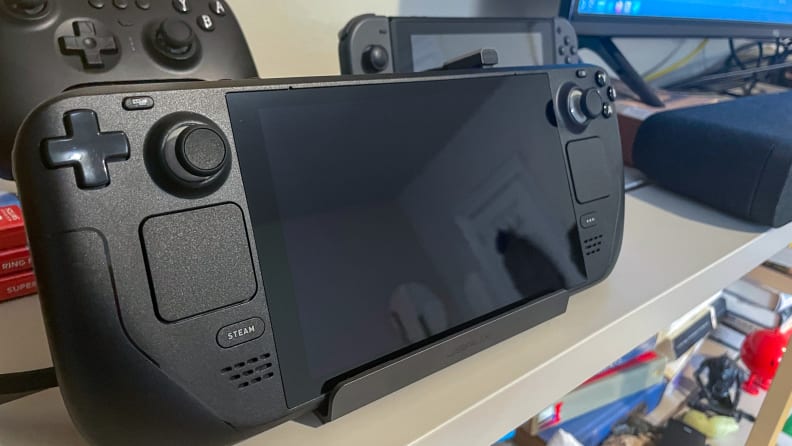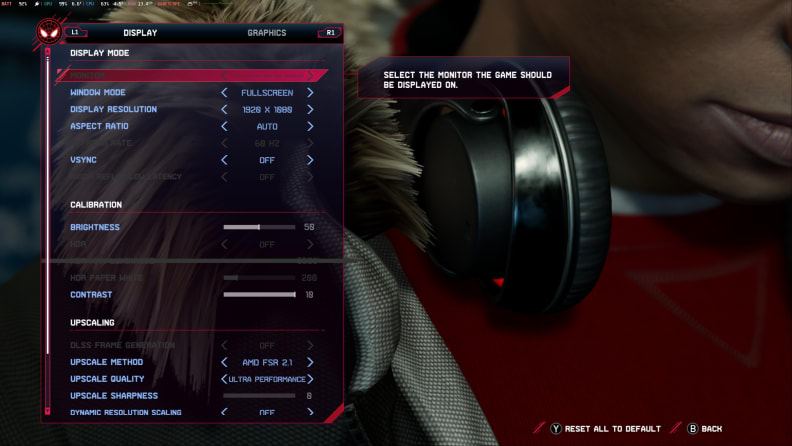Valve’s Steam Deck is a versatile handheld gaming PC that can play both new Steam games and decades of older titles thanks to its emulation capabilities. But at its heart, the Steam Deck is a Linux computer, and with a few simple accessories that you might already have lying around, you can turn it into a powerful home theater PC (HTPC) for your living room TV.
Getting set up

Credit:
Reviewed / Jonathan Hilburg
You got a few options as far as docking options go.
The first step is finding the right dock for your needs. Like the Nintendo Switch, you can slot the Steam Deck into a USB-C dock to output a signal to your TV, hook into a wired Ethernet connection, and keep your device charged.
Unfortunately, don’t expect to use one dock for both handhelds. Aside from the Steam Deck’s USB-C port being physically located on the top of the device while the Switch’s is on the bottom, Nintendo uses a proprietary HDMI handshake that ensures only docks made for the Switch will work properly.
Valve sells an official Steam Deck Docking Station for $89 that includes an HDMI 2.0 port, one DisplayPort 1.4 output, an RJ45 Ethernet port, and three USB-A 3.1 ports as well as power delivery. It’s a handy solution for connecting your Deck to a TV or monitor, but the $45 JSAUX Docking Station I tested works just as well. The company sells several varieties, up to the $130 HB0604, which includes a built-in slot for NVMe drives.
The dock isn’t the only thing you’ll need. To control your Steam Deck from across the room and play games on your TV through it, you’ll need a keyboard and mouse, or a controller at the very least. I recommend picking up peripherals with multidevice pairing; I use Corsair’s Sabre RGB Pro Wireless mouse for both my PC and Steam Deck since it can connect over 2.4GHz wireless or Bluetooth and toggle between the two at the press of a button. It’s also one of our best-rated gaming mice. You should have an easy time finding compatible hardware thanks to the dock’s USB ports.
If you want to go Bluetooth, I did all of my test gaming with the 8Bitdo Ultimate Bluetooth Controller and found the experience snappy, responsive, and lag-free.
Streaming the easy way
Now that your Steam Deck is hooked up to your TV and you can control it from the couch, you’ll likely want to add a few key programs (assuming you stick with SteamOS and don’t want to install Windows).
Adding non-Steam programs to the Deck is easy. Switch your Steam Deck to desktop mode, either through the settings menu or by holding the power button down until the option appears, and navigate to the Applications menu. You can search for Linux programs to install from there. Personally, I use Discord on the Deck this way to watch movies streamed by friends on a larger screen.
Sadly, you won’t find dedicated desktop apps on Linux for Netflix, Hulu, YouTube, HBO Max, Amazon Prime, or any of the other major streaming services. The good news is that all of these services can still be accessed through your web browser of choice. I installed Google Chrome and didn’t have any trouble watching content through any of them.
Unfortunately, if you’re thinking of downloading Plex or Emby, two popular programs for centrally managing your media content, I couldn’t get them to work on the Steam Deck. Emby refused to open after installing, and I couldn’t get past the login screen on Plex. However, Plex HTPC, the version tailored for large screens, runs just fine.
On the plus side, because of the Deck’s Bluetooth 5.0 connection, you can watch content or game using your favorite wireless headphones or gaming headset without disturbing others.
Gaming on the big screen

Credit:
Reviewed / Jonathan Hilburg
Make sure you manually change the display settings not just on your Steam Deck, but within your games as well.
Just because the Steam Deck performs best at 800p doesn’t mean you can’t game on a 4K display. Plenty of less-demanding titles and emulators can run at 60 frames per second at 4K. Getting them to run at a higher resolution than the Steam Deck can output on its own screen is easy—all you need to do is go to the settings menu for each game once docked and change the resolution.
Not that going all the way up to 4K should be necessary. Playing at 1080p was often good enough while sitting on the couch across from the living room TV, and about what the Steam Deck can push in newer games anyways. There’s always the option to fine tune the graphical settings to get the best game performance.
Thanks to AMD’s FidelityFX Super Resolution (FSR), I was able to eke out between 40 and 60 fps in Spider-Man: Miles Morales with a mix of low and medium settings at 1080p. Control lacks FSR, but you can easily surpass 30 fps by setting the display resolution to 1080p and the internal render resolution to 720p. The game still looked great, to boot.
You can push things even further with less demanding titles. Dishonored wasn’t a great experience at 4K, but lowering the resolution to 2560 × 1440 (1440p) keeps things at or near 60 fps with everything set to high. The same is true for Hades, which can’t quite maintain 60 fps at 4K but is fine at 1440p. Older emulators and 2D games should have no problem playing at 4K, if you care about pushing the best visual fidelity possible.
The other option is streaming from your own gaming PC to the Steam Deck. This is handy if you don’t want to lug your computer into the living room, and even an affordably spec’ed setup will give you magnitudes better performance. Apart from the occasional hitch, I had no issue streaming games to my TV through the Steam Deck over Wi-Fi, even at max settings with ray tracing enabled.
Troubleshooting
There are a few fixes if your Steam Deck can’t output at a full 60 fps or 120 fps at 4K out of the box. First, go into the Display section of your Deck’s settings menu. If it’s only set to 1080p, check the list of available resolutions.
If the highest available option is 4K 30Hz, the answer likely lies with your television. On my Roku set, I had to go into the HDMI secret menu and change the HDMI speed of the port my Deck was plugged into from 1.4 to 2.0. You’ll need to make sure your TV’s HDMI ports are outputting at the correct speed to take advantage of 60Hz or 120Hz gaming.
Unfortunately, you might need to do this a few times. After unplugging the dock and reattaching it to my television, I noticed that it had reset to HDMI 1.4. While this helps manufacturers ensure the broadest compatibility between their TVs and attached devices, it’s a pain if you’re trying to get the most out of your game console (not just the Steam Deck).
The product experts at Reviewed have all your shopping needs covered. Follow Reviewed on Facebook, Twitter, Instagram, TikTok, or Flipboard for the latest deals, product reviews, and more.
Prices were accurate at the time this article was published but may change over time.









